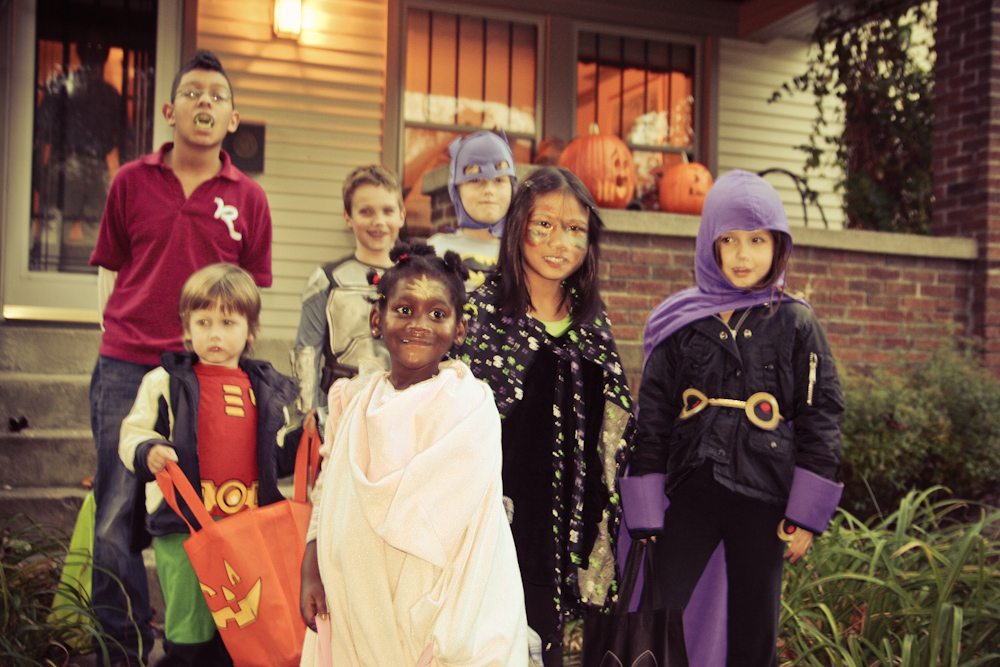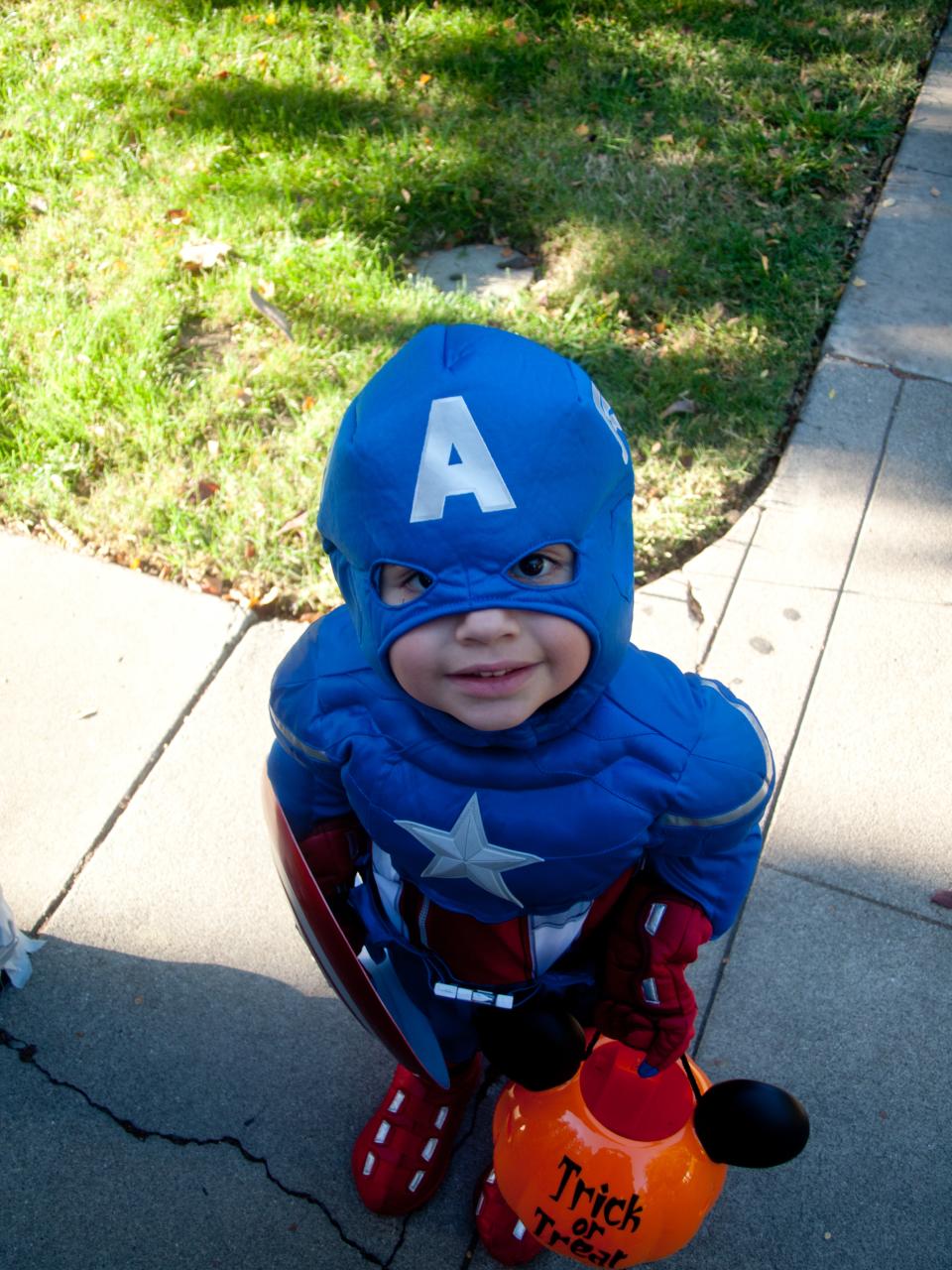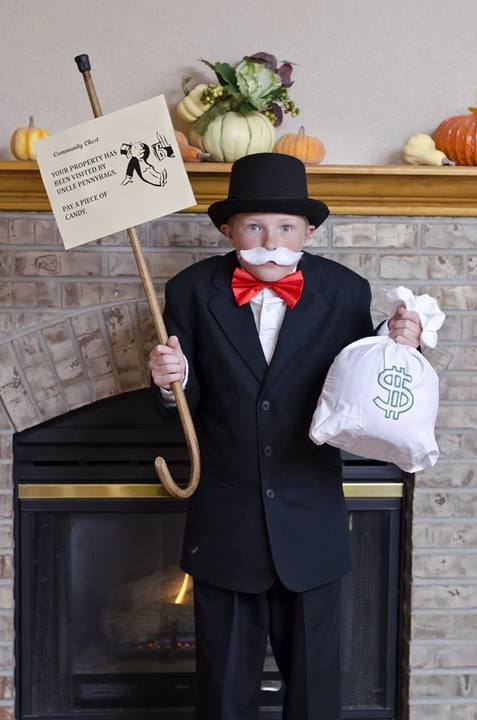
Photo by Steven Depolo, used under Creative Commons license.
Let’s talk about Halloween. It’s creeping up on us again, as it should, but while its popularity among adults continues to grow, trick-or-treating continues to decline. For many parents, the notion of letting their children participate in this tradition is practically unthinkable. If you know some of these people, I encourage you to share this post with them.
It’s my observation that there are two primary categories of people who object to Halloween: those who are afraid, and those who think it’s evil. Let’s look at each, and then we’ll move on to the claim I make in the title, that Halloween is Good For Your Kids.
People Who Are Afraid: Many people worry about safety on Halloween, and a good deal of it is driven by a relatively small number of people who seem to be afraid of everything. You know these folks; they’re the ones who keep forwarding you ridiculous e-mails about whatever the Danger of the Day happens to be. We’ve always had these people among us (the fairytale about “Chicken Little” was invented specifically to tell these people to shut the heck up), but since the advent of e-mail, they’ve had a worldwide audience and instantaneous dissemination of their paranoia. Sadly, due to the effect of the Gullibility Virus, they keep getting taken seriously.
Let’s go over it… Nobody is putting HIV-infected hypodermic needles in gas pump handles. Nobody will shoot you in the head if you flash your headlights at them. Nobody is putting dangerous things like syringes or snakes in the ball-pit at McDonald’s. Waterproof sunblock will not cause blindness. And nobody is putting poison in Halloween candy. They weren’t doing it 40 years ago when I heard the same stories, and they aren’t doing it now. Nearly every case in history of a kid finding a needle in a candy bar or drugs in their Pixy Stix has turned out to be either a hoax or an attack on a particular kid by a member of his own family.

Photo by Evan Long, used under Creative Commons license.
Look it up. It doesn’t happen. The odds of your kid having a malicious person try to harm to them on Halloween are even lower than your chances of winning the lottery. (The biggest danger trick-or-treaters face is actually cars, not people, so make sure your kids’ costumes include reflective material.) The world is statistically far safer now, especially for children, than it was 40 years ago. There are fewer child abductions and assaults now than there were when you were a kid, your kids are a lot more aware of safety than you were at their age, and stranger abductions and assaults remain extremely rare; when a child is harmed, the perpetrator is almost always someone the child knows and trusts.
The fact is, the news media plays up these exceptionally rare stories to boost ratings and fill the demands of 24-hour programming, and in so doing, they scare the crap out of parents. Well, guess what? You aren’t doing your kids any favors if you’re protecting them from all the highly unlikely things you’re afraid of. By projecting your fears onto their playtime, you’re scaring your kids, and you’re scaring yourself. Kids don’t need to be afraid of everyday life. They need a different kind of fright.
Go to your bookstore or the local library or to Amazon and get a book by Gerard Jones entitled Killing Monsters: Why Children Need Fantasy, Super Heroes, and Make-Believe Violence. Jones makes a very compelling case: Kids NEED scary make-believe violence. They need super-heroes and monsters and boogeymen. These fantasy images in all their violence and horror help to equip children to be calm and in control when facing real dangers. By successfully facing imaginary fears in a controlled environment without real-world consequence, children become more resilient and better able to handle real emergencies.
Okay, now that the paranoia is out of the way, let’s take a look at the other big objection to Halloween: It’s EEEEEE-vil!

Photo by Patrick Giblin, used under Creative Commons license.
People who think it’s evil: Some well-meaning folks have religious objections to Halloween, on the grounds that (a) it’s pagan, (b) it glorifies ungodly things, and (c) it’s anti-Christian. Let’s take a look….
It’s pagan. My response to that is “yeah, so?” If that’s your big objection, then we really need to take a look at Christmas and Easter, the two big days of the Christian calendar, both of which are soaked to the eyeballs in pagan traditions. The Christmas tree, the yule log, mistletoe, holly, Easter eggs, the Easter bunny, all of it is drawn from ancient harvest traditions and fertility rituals, some of them involving the same deities invoked at Halloween. The paganism charge as it relates to Halloween is just an excuse to cover the fact that some people find Halloween unsavory, while the bunnies and chickies are cute and non-threatening. The paganism charge doesn’t hold up if you aren’t raising it in December and April.
It glorifies evil. Again: yeah, so? The world can be a scary place. Kids need to learn to deal with scary things instead of running from them. As my mama used to say, it’s easier to put on shoes than to carpet the world. The whole point of Halloween is to overcome fear. It’s a chance to actually confront and handle their fears. It’s a chance to BE the scary one for a change. It’s also a good chance for you to teach your kids about the nature of the dark and scary world they have to live in and how to navigate it. Instead of feeding their fears, you can teach them to be brave in spite of them. If you’re concerned about the evil stuff, encourage them to dress up as heroes rather than villains; then they’re not glorifying evil, they’re fighting against it.
It’s Anti-Christian: The Jehovah’s Witnesses and some other groups have always held this view, but fifty years ago, there wasn’t another mainstream denomination that taught on the Evils of Halloween. Nobody thought that way. It was just a fun day for kids to dress up and scare each other. Charles Schulz, inventor of the Great Pumpkin, was an elder in his church. Many churches used to put on annual haunted houses full of werewolves, vampires and maniacs, and nobody thought it was wrong. So where did this fear and hatred of Halloween start?
I believe it originated with the likes of Mike Warnke and Lauren Stratford back in the 1970s. If you aren’t a practicing member of an Evangelical or Pentecostal Christian church, you’ve probably never heard of these two, so a brief explanation is in order: Mike Warnke is a preacher/comedian who once wrote a book (“The Satan Seller”) about his experiences as a priest in the Church of Satan. He used to give talks at churches where he scared folks with his tales of ritual abuse, child sacrifice and other such unsavory topics. Around the same time, Lauren Stratford (originally Laurel Rose Willson) wrote her own book (“Satan’s Underground”), in which she told lurid stories about having been subjected to horrible physical and sexual abuse at the hands of her parents, whom she claimed were satanists and had used her in their evil rituals. Warnke and Stratford both made a decent living off their appearances at churches, revival meetings, speaking engagements, appearances on Christian television, and of course, book sales.
Through their publicity campaigns the church in America was fully informed about the alleged satanic underground network of evil people abducting, raping, torturing and killing children as part of their worship of Satan, much of it involving their most sacred day of worship, Halloween.
One little problem: It never happened. Investigative journalists at Cornerstone, a now-defunct Christian magazine, looked into their claims, and they found substantial and compelling evidence to refute every claim Warnke and Stratford ever made about their backgrounds. Warnke was never a member of any Church of Satan, let alone a High Priest, and Stratford was also a fraud. They lied. Their lies had created a widespread belief in an underground satanic network of child abusers that simply didn’t exist. Naturally, Jack Chick and other evangelical figures jumped about the hysteria bandwagon, and within a few years, fear of the so-called “Satanic underground” was widespread enough to result in the appalling McMartin Preschool trial, a six-year fiasco that cost millions of dollars and resulted in zero convictions but several devastated lives.
After they were exposed, Warnke dropped the Satanism stories, wrote a book about having been “battered by religion” as a result of Cornerstone’s expose and continued to make money off personal appearances at churches. Stratford shifted focus, changed her name again (to Laura Grabowski) and began claiming to be a Holocaust survivor so as to make money off Jewish audiences. That claim was also proven false.
In the process of lying in order to build their careers, Warnke and Stratford succeeded in accidentally robbing an entire generation of the good clean fun of a Halloween party and trick-or-treating. But they did more than that. They robbed a generation of a Rite of Passage.

Photo courtesy of Randy Slavey.
Halloween is good for your kids. First, there’s the exercise of creativity and the opportunity to learn a variety of craft skills if you make your own costumes. You can teach your kids to sew, carve and sculpt in materials like styrofoam and cardboard, to paint, and to use tools like hot glue guns and utility knives safely, and that’s after they’ve done research into their costume idea and the methods to bring it about. It’s a great opportunity to learn things that aren’t on the standardized tests, and it’s a great way to avoid the marketing-driven and often sexist or otherwise inappropriate commercial costumes out there.
There’s also the transgressive nature of the whole enterprise. All year long, we tell them “don’t talk to strangers, don’t be rude, don’t take candy from people you don’t know, be inside by dark, stay with mom and dad and don’t wander off,” and a whole bunch of other rules. Then, on Halloween, we throw all the rules out the window; we tell them to stay out at night, wander around by themselves, knock on doors, talk to strangers, threaten them with pranks and extort candy from them. What could possibly be good about that?

Photo courtesy of Randy Slavey.
For one thing, it teaches them that they have the choice to break the rules. There’s something fun about breaking the rules, coloring outside the lines, going in through the exit, and Halloween provides a perfect opportunity to do just that. There is no virtue in being good only because you’re afraid to be bad. Virtue comes from choosing to be good because it’s right, But knowing when, how and why to break the rules is a useful skill to have. (A friend recently told me about a trip to IKEA with her mother, in which she decided to deliberately defy the mapped-out route through the store and go the wrong direction, entering through the exit. The entire time, her mother was looking around, fretting and worrying that they were going to get in trouble for not following the designated traffic flow. When they exited the store, Mom grinned and said “that was fun!” She learned to break the rules, after 60+ years of following them obediently. There’s value in that.)
Look at it this way: when your kids are little, you teach them not to touch the stove. It’s hot! They can get burned! At some point, you teach them how to work safely with the stove, to not be afraid of it, to be in control of it, and it changes from being a danger to being a useful appliance. Halloween serves the same function; it teaches them to navigate through right and wrong, good and evil, rather than just mindlessly obeying rules without understanding them.
Ah, but what about those of us from a Christian background, who were raised to believe Halloween is evil? Well, I believe Halloween is not anti-Christian at all, despite its pagan origins, and in fact it can be an opportunity to teach Christian values. There’s this bit in the Bible where somebody says “in all these things we are more than conquerors.” (The Greek word used for “more than conquerors,” “hypernike,” can be translated to mean “superheroes,” which sounds to me like a good justification for wearing a costume.) So Christians are supposed to be “more than conquerors” over evil, but based on the way some folks freak out about Halloween, you’d never know it. So here’s a Christian way to look at Halloween, and it’s one that kids will like a whole lot more than the lame weak-sauce “Harvest Festival” that some folks try to palm off on them as a compromise:
On the scariest night of the year, the night when evil runs free and monsters rule the land, innocent little children are supposed to go outside, into the darkness, unarmed, where they face the evil, stare it down, and come back, not only safe and sound, but with a sack full of treasure. They are supposed to learn about courage and victory and the importance of keeping your friends close by to watch out for each other. This is an illustration, an object lesson, an acting out of what we’re all supposed to do in our regular lives, to live a life of overcoming fear and conquering darkness.

Photo by Wht_wolf9653, used under Creative Commons license.
A child who goes out to trick or treat comes back a different kid. A little stronger, a little more self-assured, a little more capable. It’s a growth experience. They need it. It helps them grow up. It helps make them strong and brave. It’s Good For Them.
If your kids are old enough to cross the street by themselves and have a few friends to go out with, send them out to trick-or-treat this year. Don’t take them out; send them out. It’s an adventure. It’s good for them. It’s good for you, too. Stop being such a worry-wart. Wish them good fortune and send them on their way. (If you must, follow and watch from a distance, but don’t let them catch you at it; let them think they’re doing something extraordinary.) They will come back whole and healthy, with a skull full of good memories and some tales of adventure to share.
If you’re not letting your kids trick-or-treat, you’re missing out. You’ll never see the light in their eyes as they come home full of glee and Tootsie rolls. You’ll never hear “WOW! That was GREAT!” You’ll rob them. And you’ll rob yourself. Open the door and shove them out. You’ll thank me later.


Among the best pieces I’ve read here at GeekDad; thank you for taking the time to write it.
A terrific read – thank you!
Great article, and this conservative Christian dad heartily endorses it!